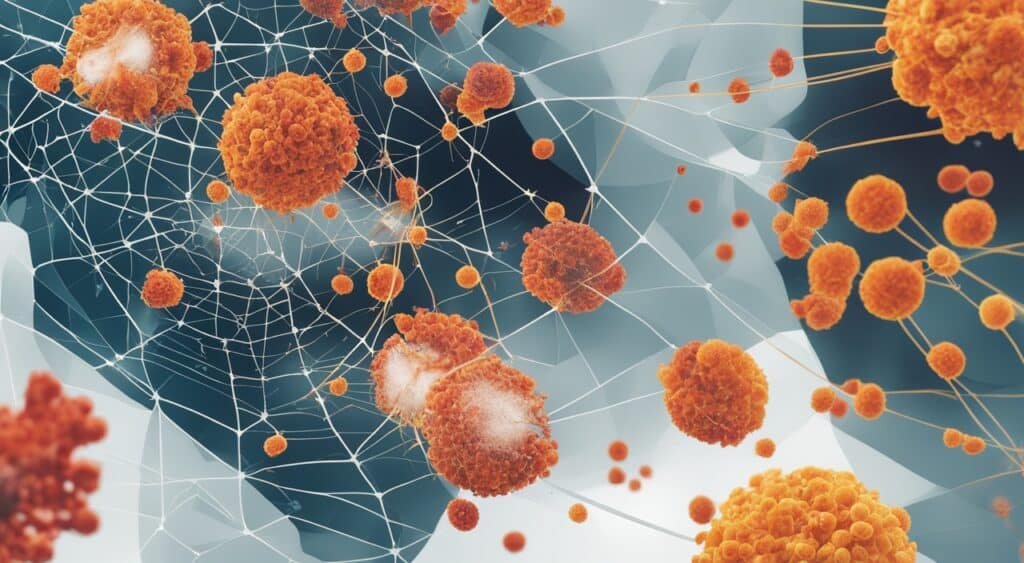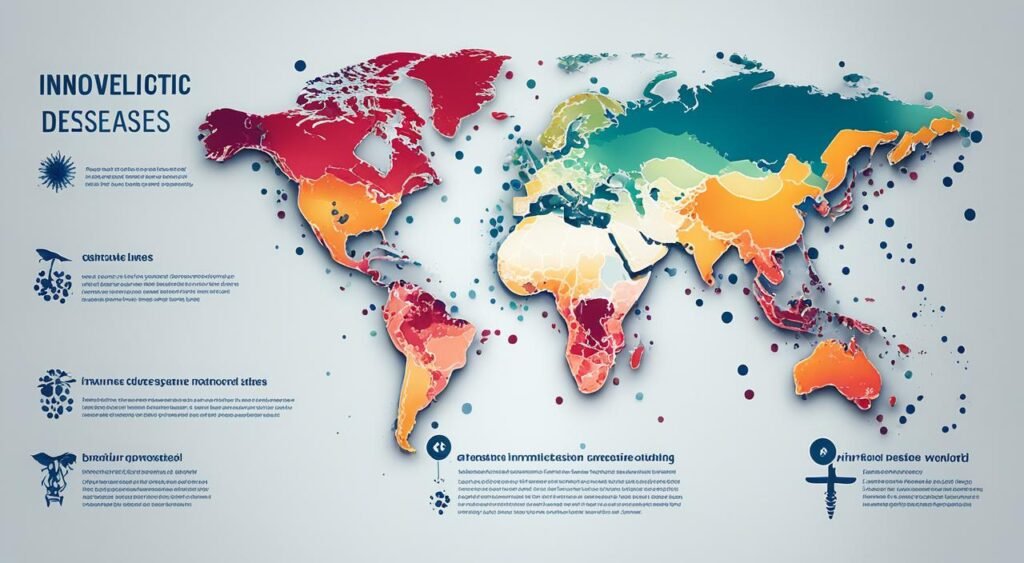Infectious diseases come from tiny life forms like bacteria, viruses, and parasites. Even though some of these live with us safely, they can turn into diseases under the wrong conditions. Infectious diseases can be passed from person to person, through the air, or by touching contaminated things. Some diseases even pass from a mother to her baby before birth. People with weak immune systems, the very young or very old, and those with ongoing health issues are more at risk.
Key Takeaways
- Infectious diseases are caused by microorganisms like bacteria, viruses, fungi, and parasites.
- These diseases can spread through direct contact, airborne transmission, contaminated food/water, and vector-borne transmission.
- Risk factors for infectious diseases include a weakened immune system, extremes of age, and chronic medical conditions.
- Proper hygiene, vaccination, and avoiding high-risk behaviors can help prevent the spread of infectious diseases.
- Emerging and re-emerging infectious diseases pose ongoing challenges to global health.
Understanding Infectious Diseases
Infectious diseases are caused by tiny living things like bacteria, viruses, fungi, or parasites. These organisms live in or on our bodies. Sometimes, they make us sick. The common signs and symptoms are things like fever, fatigue, muscle aches, coughing, and diarrhea. What you feel depends on what’s causing the infection.
What Are Infectious Diseases?
Infectious diseases come from pathogenic organisms. They include viruses, bacteria, fungi, and parasites. They sneak into our bodies and can make us really sick. These bad guys spread in different ways, like by direct contact or through the air. Knowing about these diseases is key to stopping them.
Common Signs and Symptoms
The signs of infectious diseases change, based on the pathogen and how our bodies react. You might get fever, feel tired, and have muscle aches. Other signs are coughing, sneezing, or rashes. These might point to a viral, bacterial, fungal, or parasitic infection. Spotting and treating these quickly is vital. It helps keep others from getting sick too.
Modes of Transmission

Infectious diseases can spread in many ways. These include:
Airborne Transmission
Pathogens are spread through the air in tiny droplets or aerosols. They can come from coughs, sneezes, or talking. When others breathe these in, they might get sick. Sicknesses that move this way are influenza, measles, and tuberculosis.
Droplet Transmission
Infections can also move through bigger respiratory droplets. These come from coughing, sneezing, or talking. If they land on someone’s eyes, mouth, or nose, that person might get sick. Illnesses like COVID-19, influenza, and strep throat spread this way.
Contact Transmission
Pathogens move in direct contact with someone sick or things they’ve touched. This happens when we touch our face without washing our hands. Common cold, hepatitis B, and sexually transmitted infections can spread this way.
Vector-Borne Transmission
Some illnesses need help from vectors like bugs or animals to spread. For example, mosquitoes can give us malaria, dengue, and Zika virus. Ticks can pass on Lyme disease and Rocky Mountain spotted fever.
Foodborne and Waterborne Transmission
Eating or drinking something that’s not safe can make us sick. Salmonellosis, cholera, and hepatitis A are some of the diseases we can get this way.
Risk Factors for Infectious Diseases

Some things can raise the chance of getting an infectious disease. For instance, a weak immune system, being very young or old, and having chronic medical conditions can make you more at risk.
Weakened Immune System
If your immune system is not strong, infectious diseases can be easier to catch. This happens because of health issues, some medications, and viral infections like HIV. People with weak immunity may struggle to fight off pathogens and are more likely to get seriously ill.
Age Extremes
Very young kids and the elderly have a higher risk of infectious diseases. Babies and young children may be more at risk because their immune systems aren’t fully developed. On the other hand, older people might face immune function decreases, making them more vulnerable to severe infectious disease outcomes.
Chronic Medical Conditions
Having chronic medical conditions like diabetes, cancer, or autoimmune disorders means you’re more prone to infectious diseases. These health issues can lower the immune system‘s ability to battle pathogens. As a result, the risk of getting sick from infections is higher.
Infectious Diseases and Global Burden

Infectious diseases are a big issue for global health. They cause a lot of sickness and death worldwide. The World Health Organization says they bring suffering to millions every year.
Morbidity and Mortality Rates
Infectious diseases lead to high sickness and death. Viruses, bacteria, and parasites can make people very sick. This is especially true for the old, young, and those with weak immune systems.
The COVID-19 pandemic, caused by the SARS-CoV-2 virus, has shown how bad these diseases can be. Millions have been sick and hundreds of thousands have died. Diseases like HIV/AIDS, malaria, tuberculosis, and hepatitis are also big problems, especially in developing countries.
Impact in Developing Countries
Developing countries face more of these diseases. They have less access to healthcare and vaccinations. Also, poverty and poor living conditions help these diseases spread faster.
Malaria, dengue, and neglected tropical diseases hurt the health and economy of these countries. They cause a lot of sickness, death, and work lost. It’s very important to make disease prevention and treatment better worldwide.
Emerging and Re-Emerging Infectious Diseases
The world of infectious diseases keeps changing, bringing new challenges. New and re-emerging pathogens constantly test global public health. When new viruses, bacteria, and other infectious agents appear, they can cause big problems. They might start with small outbreaks but can grow into epidemics or even worldwide pandemics.
New Pathogens
Lately, new infectious diseases have shown up, thanks to unfamiliar pathogens. The COVID-19 outbreak, from the SARS-CoV-2 virus, is a key example. It’s had a huge impact worldwide, leading to many getting sick and dying. Diseases like Ebola, Zika, and Chikungunya have also created big problems in different places.
Evolving Pathogens
Not only are new pathogens a concern, but old ones can surprise us too. Take influenza viruses, for example. They keep changing, making it hard for our bodies and vaccines to fight them. The spread of antibiotic-resistant bacteria, or “superbugs,” is also worrying. They show how pathogens can outsmart our efforts to control diseases. This kind of threat is dangerous to global public health.
Also Read : Soothing Sensations: Menopause Skincare Solutions
Infectious Disease Prevention
It’s very important to stop the spread of infectious diseases for everyone’s health. Strengthen your defenses with vaccination. Keep your hands clean with hand hygiene. Also, handle food safely and avoid risky behaviors.
Vaccination
Vaccines are a key way to fight off infections. They help your body’s immune system fight disease. Diseases like smallpox, polio, and measles have been largely controlled thanks to vaccines.
Hand Hygiene
Washing your hands is an easy but important step. Do this often with soap and water. Using an alcohol-based hand sanitizer works when clean water isn’t available. Doing this keeps germs off and lowers the risk of getting sick. Always remember to wash up before eating, after using the restroom, and when you cough or sneeze.
Safe Food Handling
Taking care with food helps prevent sickness that comes from eating. Make sure you cook meat and poultry fully. Keep cooked food away from raw items. Store food that goes bad fast at the right temperature. Following these steps makes food poisoning and foodborne illnesses less likely.
Avoiding High-Risk Behaviors
Some behaviors, like risky sex and drug use, can up your chance of getting sick. Diseases such as HIV, hepatitis, and others can spread this way. It’s best to avoid these behaviors and use protective measures. This can prevent the spread of serious illnesses.
FAQs
Q: What is the main way infectious diseases spread among populations?
A: Infectious diseases primarily spread through direct or indirect contact with an infected individual, contaminated surfaces, or vectors such as mosquitoes or ticks.
Q: How does microbiology play a role in understanding infectious diseases?
A: Microbiology helps in studying the characteristics, behavior, and mechanisms of microorganisms that cause infectious diseases, aiding in their prevention and control.
Q: What is the significance of epidemiology in managing infectious diseases?
A: Epidemiology is crucial in tracking the patterns and spread of infectious diseases, identifying risk factors, and implementing control measures to prevent outbreaks.
Q: What are some common types of infectious diseases?
A: Common types of infectious diseases include bacterial infections, viral infections like HIV and coronavirus, fungal infections, and parasitic diseases.
Q: How do infectious diseases differ from non-infectious diseases?
A: Infectious diseases are caused by pathogens such as bacteria, viruses, fungi, or parasites and can be spread from one person to another, while non-infectious diseases are typically not transmissible.
Q: What role does disease control play in preventing infectious diseases?
A: Disease control measures such as vaccination, hygiene practices, surveillance, and antimicrobial treatments are essential in preventing the spread of infectious diseases and reducing their impact on populations.
Q: How does infectious disease research contribute to the field of public health?
A: Infectious disease research helps in understanding the causes, transmission routes, prevention strategies, and treatment options for various infectious diseases, guiding public health interventions and policies.
Source Links
- https://www.sahealth.sa.gov.au/wps/wcm/connect/public content/sa health internet/conditions/infectious diseases/ways infectious diseases spread
- https://www.mayoclinic.org/diseases-conditions/infectious-diseases/symptoms-causes/syc-20351173
- https://www.ncbi.nlm.nih.gov/pmc/articles/PMC7176237/




